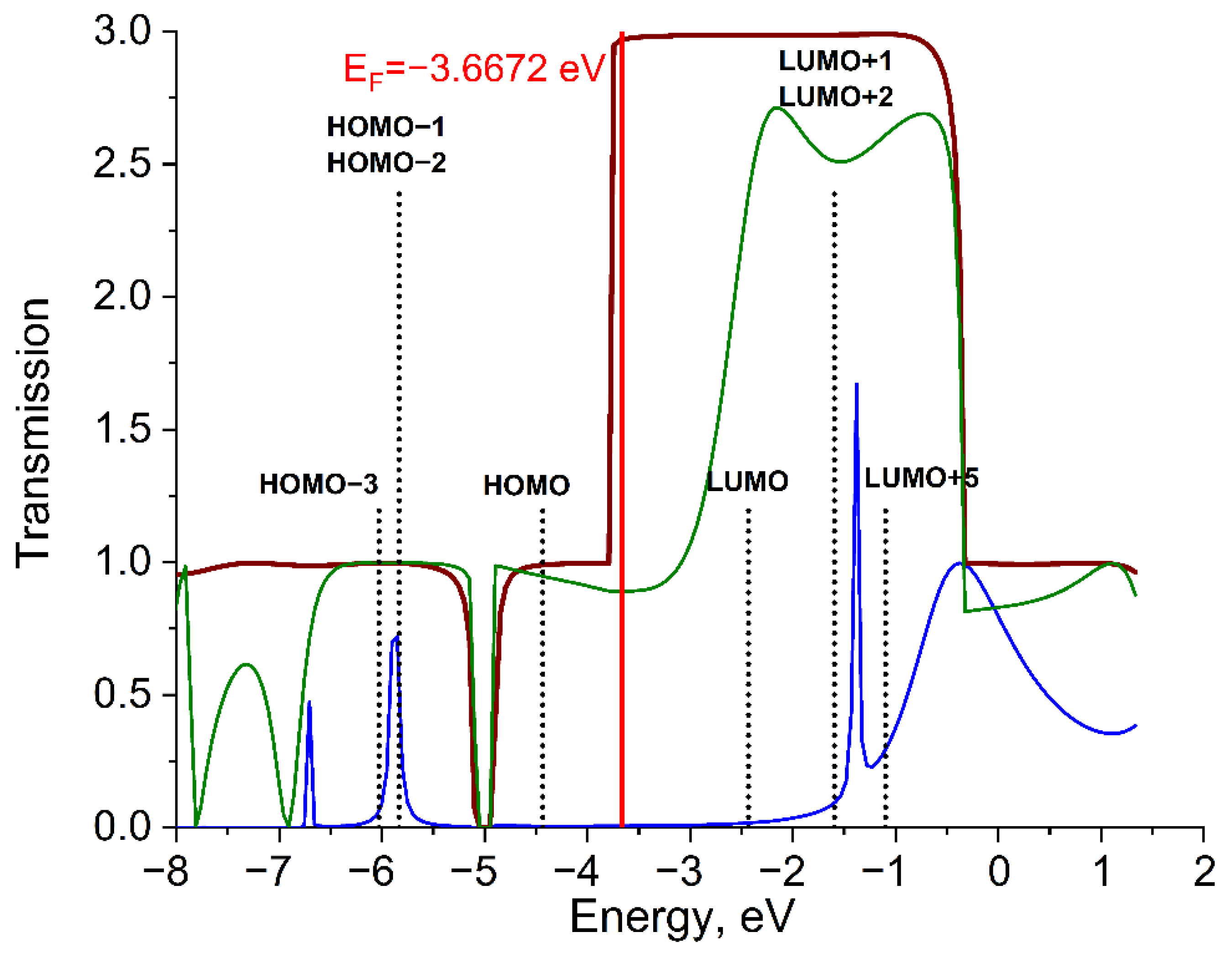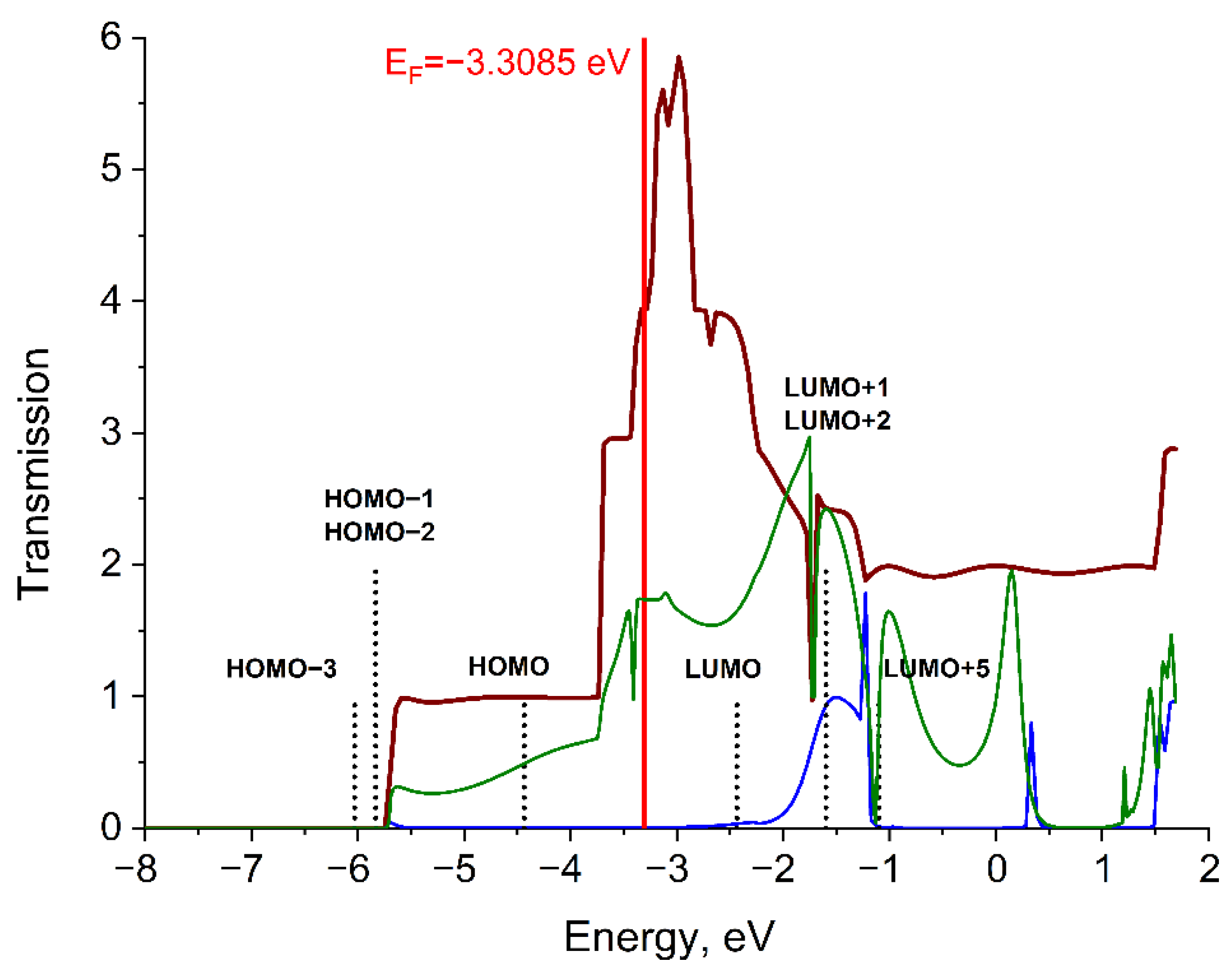The Role of Quadruple Bonding in the Electron Transport through a Dimolybdenum Tetraacetate Molecule
Abstract
1. Introduction
2. Results and Discussion
2.1. Quadruple Bond in Mo2(O2CCH3)4 Molecule
2.2. Electron Transport through Systems M6–(Mo2(O2CCH3)4)–M6 (M = Li, Al, Ti)
2.2.1. System Li6–(Mo2(O2CCH3)4)–Li6
2.2.2. System Al6–(Mo2(O2CCH3)4)–Al6
2.2.3. System Ti6–(Mo2(O2CCH3)4)–Ti6
2.2.4. Discussion
3. Theoretical Calculations
4. Conclusions
Supplementary Materials
Author Contributions
Funding
Institutional Review Board Statement
Informed Consent Statement
Data Availability Statement
Conflicts of Interest
References
- Cotton, F.A.; Mester, Z.C.; Webb, T.R. Dimolybdenum tetraacetate. Acta Crystallogr. Sect. B Struct. Crystallogr. Cryst. Chem. 1974, 30, 2768–2770. [Google Scholar] [CrossRef]
- Kelley, M.H.; Fink, M. The molecular structure of dimolybdenum tetra-acetate. J. Chem. Phys. 1982, 76, 1407–1416. [Google Scholar] [CrossRef]
- Benard, M. A study of Hartree–Fock instabilities in Cr2(O2CH)4 and Mo2(O2CH)4. J. Chem. Phys. 1979, 71, 2546–2556. [Google Scholar] [CrossRef]
- Blaudeau, J.P.; Pitzer, R.M. Ab initio studies of ligand effects on the metal-metal bond in dimolybdenum complexes. J. Phys. Chem. 1994, 98, 4575–4579. [Google Scholar] [CrossRef]
- Cotton, F.A.; Murillo, C.A.; Walton, R.A. Multiple Bonds between Metal Atoms; Springer Science & Business Media: Berlin, Germany, 2005. [Google Scholar]
- Cotton, F.A. Spectroscopic and quantum theoretical studies of species with metal-to-metal bonds. J. Mol. Struct. 1980, 59, 97–108. [Google Scholar] [CrossRef]
- Martin, D.S.; Newman, R.A.; Fanwick, P.E. Polarized electronic absorption spectra for dimolybdenum(II) tetraacetate. Inorg. Chem. 1979, 18, 2511–2520. [Google Scholar] [CrossRef]
- Aeschlimann, S.; Bauer, S.V.; Vogtland, M.; Stadtmüller, B.; Aeschlimann, M.; Floris, A.; Bechstein, R.; Kühnle, A. Creating a regular array of metal-complexing molecules on an insulator surface at room temperature. Nat. Commun. 2020, 11, 6424. [Google Scholar] [CrossRef]
- Aeschlimann, S.; Lyu, L.; Stadtmüller, B.; Aeschlimann, M.; Kühnle, A. Tailoring molecular island shapes: Influence of microscopic interaction on mesostructured. Nano Res. 2020, 13, 843–852. [Google Scholar] [CrossRef]
- Kollamana, J.; Wei, Z.; Lyu, L.; Zimmer, M.; Dietrich, F.; Eul, T.; Stöckl, J.; Maniraj, M.; Ponzoni, S.; Cinchetti, M.; et al. Control of Cooperativity through a Reversible Structural Phase Transition in MoMo-Methyl/Cu(111). Adv. Funct. Mater. 2017, 28, 1703544. [Google Scholar] [CrossRef]
- Datta, S. Quantum Transport: Atom to Transistor; Cambridge University Press: Cambridge, UK, 2005; pp. 33–50. [Google Scholar]
- Verzijl, C.J.O.; Thijssen, J.M. DFT-based molecular transport implementation in ADF/BAND. J. Phys. Chem. C 2012, 116, 24393–24412. [Google Scholar] [CrossRef]
- Li, R.; Zhang, J.; Hou, S.; Qian, Z.; Shen, Z.; Zhao, X.; Xue, Z. A corrected NEGF+DFT approach for calculating electronic transport through molecular devices: Filling bound states and patching the non-equilibrium integration. Chem. Phys. 2007, 336, 127–135. [Google Scholar] [CrossRef]
- Lambert, C.J. Basic concepts of quantum interference and electron transport in single-molecule electronics. Chem. Soc. Rev. 2015, 44, 875–888. [Google Scholar] [CrossRef] [PubMed]
- Slater, J.C. Atomic radii in crystals. J. Chem. Phys. 1964, 41, 3199–3204. [Google Scholar] [CrossRef]
- Verzijl, C.J.O.; Seldenthuis, J.S.; Thijssen, J.M.; Verzijl, C.J.O.; Seldenthuis, J.S.; Thijssen, J.M.; Verzijl, C.J.O.; Seldenthuis, J.S.; Thijssen, J.M.; Verzijl, C.J.O.; et al. Applicability of the wide-band limit in DFT-based molecular transport calculations. J. Chem. Phys. 2013, 138, 094102. [Google Scholar] [CrossRef]
- Velde, G.T.; Bickelhaupt, F.M.; Baerends, E.J.; Fonseca Guerra, C.; van Gisbergen, S.J.A.; Snijders, J.G.; Ziegler, T. Chemistry with ADF. J. Comp. Chem. 2001, 22, 931–967. [Google Scholar] [CrossRef]
- ADF 2020.102, SCM, Theoretical Chemistry, Vrije Universiteit, Amsterdam, The Netherlands. Available online: http://www.scm.com (accessed on 30 September 2022).
- Perdew, J.P.; Burke, K.; Ernzerhof, M. Generalized gradient approximation made simple. Phys. Rev. Lett. 1996, 77, 3865. [Google Scholar] [CrossRef] [PubMed]
- van Lenthe, E.; Baerends, E.J. Optimized Slater-type basis sets for the elements 1–118. J. Comput. Chem. 2003, 24, 1142–1156. [Google Scholar] [CrossRef] [PubMed]
- van Lenthe, E.; Ehlers, A.; Baerends, E.-J. Geometry optimizations in the zero order regular approximation for relativistic effects. J. Chem. Phys. 1999, 110, 8943–8953. [Google Scholar] [CrossRef]
- Velde, G.T.; Baerends, E.J. Precise density-functional method for periodic structures. Phys. Rev. B 1991, 44, 7888–7903. [Google Scholar] [CrossRef]
- BAND 2020.102, SCM, Theoretical Chemistry, Vrije Universiteit, Amsterdam, The Netherlands. Available online: https://www.scm.com (accessed on 10 October 2022).
- Becke, A.D. Density-functional exchange-energy approximation with correct asymptotic behavior. Phys. Rev. A 1988, 38, 3098. [Google Scholar] [CrossRef]
- Perdew, J.P. Density-functional approximation for the correlation energy of the inhomogeneous electron gas. Phys. Rev. B 1986, 33, 8822–8824. [Google Scholar] [CrossRef] [PubMed]
- Perdew, J.P. Erratum: Density-functional approximation for the correlation energy of the inhomogeneous electron gas. Phys. Rev. B 1986, 34, 7406. [Google Scholar] [CrossRef]
- Philipsen, P.H.T.; Baerends, E.J. Relativistic calculations to assess the ability of the generalized gradient approximation to reproduce trends in cohesive properties of solids. Phys. Rev. B 2000, 61, 1773–1778. [Google Scholar] [CrossRef]
- Nadler, M.R.; Kempier, C.P. Crystallographic data 186. Lithium. Anal. Chem. 1959, 31, 2109. [Google Scholar] [CrossRef]
- Wang, K.; Reeber, R.R. The perfect crystal, thermal vacancies and the thermal expansion coefficient of aluminium. Philos. Mag. A 2000, 80, 1629–1643. [Google Scholar] [CrossRef]
- Pawar, R.R.; Deshpande, V.T. The anisotropy of the thermal expansion of α-titanium. Acta Cryst. A 1968, 24, 316–317. [Google Scholar] [CrossRef]
- Buehl, M.; Reimann, C.; Pantazis, D.A.; Bredow, T.; Neese, F. Geometries of Third-Row Transition-Metal Complexes from Density-Functional Theory. J. Chem. Theory Comput. 2008, 4, 1449–1459. [Google Scholar] [CrossRef]
- Smit, R. H. M.; Untiedt, C.; Rubio-Bollinger, G.; Segers, R.C.; van Ruitenbeek, J.M. Observation of a parity oscillation in the conductance of atomic wires. Phys. Rev. Lett. 2003, 91, 076805. [Google Scholar] [CrossRef]
- Kizuka, T. Atomic configuration and mechanical and electrical properties of stable gold wires of single-atom width. Phys. Rev. B 2008, 77, 155401. [Google Scholar] [CrossRef]
- Lu, Y.; Lou, J. Quantitative in-situ nanomechanical characterization of metallic nanowires. JOM 2011, 63, 35–42. [Google Scholar] [CrossRef]





Publisher’s Note: MDPI stays neutral with regard to jurisdictional claims in published maps and institutional affiliations. |
© 2022 by the authors. Licensee MDPI, Basel, Switzerland. This article is an open access article distributed under the terms and conditions of the Creative Commons Attribution (CC BY) license (https://creativecommons.org/licenses/by/4.0/).
Share and Cite
Arentov, D.O.; Ryzhikov, M.R.; Kozlova, S.G. The Role of Quadruple Bonding in the Electron Transport through a Dimolybdenum Tetraacetate Molecule. Molecules 2022, 27, 6912. https://doi.org/10.3390/molecules27206912
Arentov DO, Ryzhikov MR, Kozlova SG. The Role of Quadruple Bonding in the Electron Transport through a Dimolybdenum Tetraacetate Molecule. Molecules. 2022; 27(20):6912. https://doi.org/10.3390/molecules27206912
Chicago/Turabian StyleArentov, Dmitry O., Maxim R. Ryzhikov, and Svetlana G. Kozlova. 2022. "The Role of Quadruple Bonding in the Electron Transport through a Dimolybdenum Tetraacetate Molecule" Molecules 27, no. 20: 6912. https://doi.org/10.3390/molecules27206912
APA StyleArentov, D. O., Ryzhikov, M. R., & Kozlova, S. G. (2022). The Role of Quadruple Bonding in the Electron Transport through a Dimolybdenum Tetraacetate Molecule. Molecules, 27(20), 6912. https://doi.org/10.3390/molecules27206912






